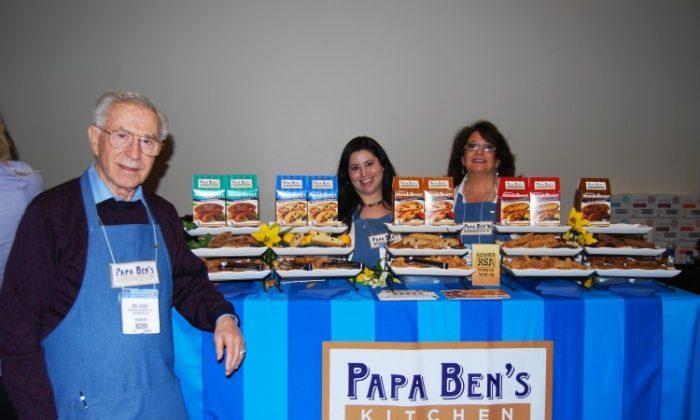SAN FRANCISCO—From blood orange chili juice to broccoli tea, or all-natural dietary-specific organic homemade treats, specialty foods are on the rise.
What’s special about specialty food, which can range from uncommon flavors to ethnic cuisine, or even just things of a “better than mass market quality,” is that it is nearly always a personal endeavor.
“In a little piece of chocolate, you can put so much flavor, but you can also be artistic with it. I take chocolate and make sculptures ... and it’s just pure art,” said Shawn Williams of Feve Artisan Chocolatier. “I love that.”
Feve, which recently won the 2013 Good Food Award, was rebranded last year by Williams with new packaging and “things I’ve been wanting to do for years.”
Specialty food is personal. With the increasing ease of accessibility of foods due to farmer’s markets, food trucks, and pop-up restaurants, loving food is reason enough to start a brand.
Since specialty food producers are putting their own twists on their products, the combinations are endless—and consumers are responding.
Nearly two-thirds of American consumers buy specialty food products, and specialty products now make up 13 percent of the entire food industry, according to Nielsen.
The Specialty Food Experience
Ron Tanner, spokesman for the National Association of Specialty Food Trade (NASFT), said, “I think people like to treat themselves, and treating themselves with a nice spice mixture, or a coffee or cheese, is a really kind of easy and inexpensive way to do that.”
Nearly 18,000 buyers flooded the Moscone Center in San Francisco from Sunday to Tuesday for NASFT’s 38th Annual Winter Fancy Food Show, to see over 80,000 products from 1,300 exhibitors from over 35 different countries.
“I see things from around the country and from around the world that I will never get to see unless I come to this show, and I bring that back to my customers,” said Kay Timm, who owns an upscale specialty food shop in Wisconsin.
Timm had only gone through one of the rooms, and she said already “I’ve seen a lot of things I love here, I’ve probably got about 20 new products that I'll be bringing in,” she said.
As with all dishes, for specialty food, appearance is as important as taste. Retailer after retailer noted the impressive packaging at the show this year, which does make a difference in distinguishing one kale chip from another.
Packaging and design were crucial to Feve’s rebranding success, and play a major role in many specialty food lines.
George Bryson said it took about a year to complete concept design and get the bottles and caps for Wild Poppy Juice Company, which he started with his 10-year-old daughter last year.
“We started bottling things in the kitchen, with cocktail shakers, making juices,” Bryson said. Their juices are fruit-and-spice mixes, like Grapefruit Ginger, Plum Licorice, and Blood Orange Chili, which has more kick than a carbonated drink.
“Eventually our dream is to have relationships with dozens of [California] farmers, and then we'd roll out seasonal flavors. If somebody has a great kiwi, or a great fig, we could make a drink,” Bryson said.
Odds and Ends
Consumers expect specialty food to be a little different, and David Sasuga’s microgreens are far from your standard supermarket vegetables.
For Sasuga, these edible flowers and cucumbers the size of a nickel aren’t so out of the ordinary, as he has been growing things his entire life. “My grandfather was a plant guy, and he instilled that into me, somehow,” Sasuga said. “He was always making cuttings and planting strange seeds he would collect.”
But specialty food items aren’t always concoctions of strange pairings and unusual flavors.
Gabriel Lightfriend of Castle Rock Water, said he'd been chasing rights to the Mt. Shasta spring for about 15 years. The spring, located in Dunsmuir, Calif., has a long history. It’s been bottled for over a hundred years and townspeople and overseas researchers have boasted its health benefits.
When Coca-Cola released the rights to the spring, “we jumped on it,” Lightfriend said. “We tasted it—it’s just incredible.”
An Edible Statement
Specialty food tends to come with a message.
Ned Heagerty of Silk Road Teas will make his first foray into branding this February. “These are really well-made Chinese teas, and essentially what I’m saying is, stay out of the way,” meaning that the flavors of these teas should be enjoyed in their purest form.
“I’ve tried to preserve it and bring it back here and present the best possible Chinese tea that we can. No additives. I think Chinese teas bring very wonderful tastes and flavors to the palette, if you have the opportunity to drink them and don’t put anything in them,” Heagerty said.
Passionate entrepreneurs often “bring a dish to the table” when they see a gap in the market, but many brands are also part of a larger project.
Ben Lesser, of Papa Ben’s Kitchen, is a Holocaust survivor who has dedicated years of his life to speaking about his experience.
Lesser said the students and people he spoke to were often so touched that they wanted a tangible keepsake, so the foundation he started would give away pins reading “Zachor,” which means “Remember.”
“But we ran out of money,” he said.
Lesser recalled that his father had become, by necessity, a baker. “My father had the same problem during the war, everything was taken from him and he had to feed a family of seven,” Lesser said. His father was given a sack of flour to bake bread for the family—but instead he made pretzels.
“He took it to neighboring bars and he started to sell the pretzels. It was a novelty,” Lesser said. “After he sold a few pretzels, he was able now to bake bread for the family, and before he knew it, he became a baker in that little town.”
“When I retired, I don’t know why, I started to bake. Maybe I felt a connection, a closeness to the family,” Lesser said, and now Papa Ben’s is run by three generations within his family, and a percentage of the proceeds goes toward the foundation.









